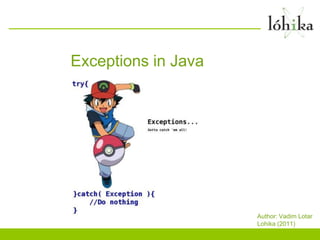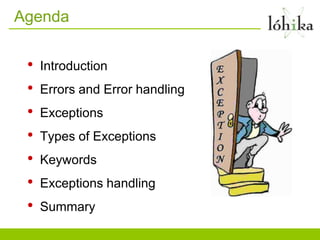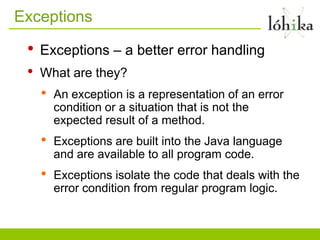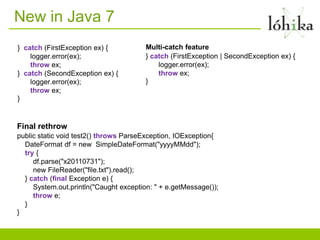Exceptions in Java
- 1. Exceptions in Java Author: Vadim Lotar Lohika (2011)
- 2. Agenda • Introduction • Errors and Error handling • Exceptions • Types of Exceptions • Keywords • Exceptions handling • Summary
- 3. Introduction • Customers have high expectations for the code we produce. • Users will use our programs in unexpected ways. • Due to design errors or coding errors, our programs may fail in unexpected ways during execution • It is our responsibility to produce quality code that does not fail unexpectedly. • Consequently, we must design error handling into our programs.
- 4. Errors and Error handling • An Error is any unexpected result obtained from a program during execution. • Unhandled errors may manifest themselves as incorrect results or behavior, or as abnormal program termination. • Errors should be handled by the programmer, to prevent them from reaching the user.
- 5. Errors and Error handling • Memory errors (i.e memory incorrectly allocated, memory leaks…) • File system errors (i.e. disk is full…) • Network errors (i.e. network is down…) • Calculation errors (i.e. divide by 0) • Array errors (i.e. accessing element –1) • Conversion errors (i.e. convert „q‟ to a number) • Can you think of some others?
- 6. Errors and Error handling • Every method returns a value (flag) indicating either success, failure, or some error condition. • Cons: developer must remember to always check the return value and take appropriate action. • Where used: traditional programming languages (i.e. C) use this method for almost all library functions
- 7. Errors and Error handling • Create a global error handling routine, and use some form of “jump” instruction to call this routine when an error occurs • Cons: “jump” instruction (GoTo) are considered “bad programming practice” and are discouraged • Where used: many older programming texts (C, FORTRAN) recommended this method to programmers.
- 8. Exceptions
- 9. Exceptions • Exceptions – a better error handling • What are they? • An exception is a representation of an error condition or a situation that is not the expected result of a method. • Exceptions are built into the Java language and are available to all program code. • Exceptions isolate the code that deals with the error condition from regular program logic.
- 10. Types of Exceptions • Unchecked Exceptions • Checked Exceptions It is not required that these types Must either be caught by a of exceptions be caught or method or declared in its declared on a method. signature. • Runtime exceptions can be • Placing exceptions in the generated by methods or by method signature harkens the JVM itself. back to a major concern for Goodenough. • Errors are generated from deep within the JVM, and • This requirement is viewed often indicate a truly fatal with derision in the state. hardcore C++ community. • Runtime exceptions are a • A common technique for source of major controversy! simplifying checked exceptions is subsumption.
- 11. Types of Exceptions Throwable The base class for all exceptions. Error Indicates serious problems that a reasonable application should not try to catch. Most such errors are abnormal conditions. Exception Anything which should be handled by the invoker. java.lang.Throwable java.lang.Error java.lang.Exception java.lang.ThreadDeath java.lang.RuntimeException java.io.IOException java.lang.NullPointerException java.lang.IllegalArgumentException java.io.FileNotFoundException
- 12. Types of Exceptions • Three Critical Decisions: • How do you decide to raise an exception rather than return? 1. Is the situation truly out of the ordinary? 2. Should it be impossible for the caller to ignore this problem? 3. Does this situation render the class unstable or inconsistent? • Should you reuse an existing exception or create a new type? 1. Can you map this to an existing exception class? 2. Is the checked/unchecked status of mapped exception acceptable? 3. Are you masking many possible exceptions for a more general one? • How do you deal with subsumption in a rich exception hierarchy? 1. Avoid throwing a common base class (e.g. IOException). 2. Never throw an instance of the Exception or Throwable classes.
- 13. Keywords • throws Describes the exceptions which can be raised by a method. • throw Raises an exception to the first available handler in the call stack, unwinding the stack along the way. • try Marks the start of a block associated with a set of exception handlers. • catch If the block enclosed by the try generates an exception of this type, control moves here; watch out for implicit subsumption. • finally Always called when the try block concludes, and after any necessary catch handler is complete.
- 14. Keywords public void setProperty(String p_strValue) throws NullPointerException { if (p_strValue == null) {throw new NullPointerException(“...”);} } public void myMethod() { MyClass oClass = new MyClass(); try { oClass.setProperty(“foo”); oClass.doSomeWork(); } catch (NullPointerException npe) { System.err.println(“Unable to set property: “+npe.toString()); } finally { oClass.cleanup(); } }
- 15. Keywords • throw(s) /* The IllegalArgumentException is considered unchecked, and * even making it part of the signature will not alter that. */ public void setName(String p_strName) throws IllegalArgumentException { /* valid names cannot be zero length */ if (p_strName.length() == 0) { throw new IllegalArgumentException(“…”); } m_strName = p_strName; } public void foo() { setName(“”); /* No warning about unhandled exceptions. */ }
- 16. Keywords • throw(s) /* Make a bad parameter exception class */ class NuttyParameterException extends Exception { … } /* To really make an invoker pay attention, use a checked * exception type rather than a Runtime Exception type, but you must declare that you will throw the type! */ public void setName(String p_strName) throws NuttyParameterException { /* valid names cannot be zero length */ if (p_strName == null || p_strName.length() == 0) { throw new NuttyParameterException(“…”); } m_strName = p_strName; } /* Many of us will have an unquenchable desire to use a Runtime * exception in the above, but resist! */ public void foo() { setName(“”); /* This does result in an error. */ }
- 17. Keywords • try /* The try statement marks the position of the first bytecode instruction * protected by an exception handler. */ try { UserRecord oUser = new UserRecord(); oUser.setName(“Mr. XXX”); oUser.store(); /* This catch statement then marks the final bytecode instruction protected, and begins the list of exceptions handled. This info is collected and is stored in the exception table for the method. */ } catch (CreateException ce) { System.err.println(“Unable to create user record in the database.”); }
- 18. Keywords • catch /* A simple use of a catch block is to catch the exception raised by the code from a prior slide. */ try { myObject.setName(“foo”); } catch (NuttyParameterException npe) { System.err.println(“Unable to assign name: “ + npe.toString()); } try { /* example 2 */ myObject.setName(“foo”); } catch (NuttyParameterException npe) { /* log and relay this problem. */ System.err.println(“Unable to assign name: “ + npe.toString()); throw npe; }
- 19. Keywords • catch /* Several catch blocks of differing types can be concatenated. */ try { URL myURL = new URL("http://www.mainejug.org"); InputStream oStream = myURL.openStream(); byte[] myBuffer = new byte[512]; int nCount = 0; while ((nCount = oStream.read(myBuffer)) != -1) { System.out.println(new String(myBuffer, 0, nCount)); } oStream.close(); } catch (MalformedURLException mue) { System.err.println("MUE: " + mue.toString()); } catch (IOException ioe) { System.err.println("IOE: " + ioe.toString()); }
- 20. Keywords • finally URL myURL = null; InputStream oStream = null; /* The prior sample completely neglected to discard the network * resources, remember that the GC is non-determinstic!! */ try { /* Imagine you can see the code from the last slide here... */ } finally { /* What two things can cause a finally block to be missed? */ /* Since we cannot know when the exception occurred, be careful! */ try { oStream.close(); } catch (Exception e) { } }
- 21. Keywords • finally public boolean anotherMethod(Object myParameter) { try { /* What value does this snippet return? */ myClass.myMethod(myParameter); return true; } catch (Exception e) { System.err.println(“Exception in anotherMethod()“ +e.toString()); return false; } finally { /* If the close operation can raise an exception, whoops! */ if (myClass.close() == false) { break; } 1. True } 2. False return false; } 3. An exception 4. Non of above
- 22. Keywords • finally public void callMethodSafely() { while (true) { /* How about this situation? */ try { /* Call this method until it returns false. */ if (callThisOTherMethod() == false) { return; } } finally { 1. Infinite loop continue; 2. 1 } 3. 2 } /* end of while */ 4. An exception } public boolean callThisOTherMethod() { return false; }
- 23. Practice /* Since UnknownHostException extends IOException, the catch block associated with the former is subsumed. */ try { Socket oConn = new Socket(“www.sun.com”, 80); } catch (IOException ioe) { } catch (UnknownHostException ohe) { } /* The correct structure is to arrange the catch blocks with the most derived class first, and base class at the bottom. */ try { Socket oConn = new Socket(“www.sun.com”, 80); } catch (UnknownHostException ohe) { } catch (IOException ioe) { }
- 24. Practice class MyThread implements Runnable { public MyTask m_oTask = null; public void run() { if (m_oTask == null) { throw new IllegalStateException(“No work to be performed!”); } else { /* Do the work of the thread. */ } } } public void foo() { MyThread oThread = new MyThread(); /* There is no way to get the exception from the run() method! */ new Thread(oThread).start(); /* Good reason for Runtime choice!! */ }
- 25. Practice public interface ITest { void test() throws IOException ; } public class TestImpl implements ITest{ public void test() throws IOException, InvalidArgumentException { //some code } public void test() throws IOException, FileNotFoundException { //some code } public void test() { //some code } public void test() throws IOException { //some code } }
- 26. New in Java 7 } catch (FirstException ex) { Multi-catch feature logger.error(ex); } catch (FirstException | SecondException ex) { throw ex; logger.error(ex); } catch (SecondException ex) { throw ex; logger.error(ex); } throw ex; } Final rethrow public static void test2() throws ParseException, IOException{ DateFormat df = new SimpleDateFormat("yyyyMMdd"); try { df.parse("x20110731"); new FileReader("file.txt").read(); } catch (final Exception e) { System.out.println("Caught exception: " + e.getMessage()); throw e; } }
- 27. New in Java 7 public class OldTry { public static void main(String[] args) { OldResource res = null; try { res = new OldResource(); res.doSomeWork("Writing an article"); } catch (Exception e) { System.out.println("Exception Message: " + e.getMessage() + " Exception Type: " + e.getClass().getName()); } finally { try { res.close(); } catch (Exception e) { System.out.println("Exception Message: " + e.getMessage() + " Exception Type: " + e.getClass().getName()); } } } } public class TryWithRes { public static void main(String[] args) { try(NewResource res = new NewResource("Res1 closing")){ res.doSomeWork("Listening to podcast"); } catch(Exception e){ System.out.println("Exception: "+ e.getMessage()+" Thrown by: "+e.getClass().getSimpleName()); } } }
- 28. Summary • Exceptions are a powerful error handling mechanism. • Exceptions in Java are built into the language. • Exceptions can be handled by the programmer (try-catch), or handled by the Java environment (throws).
- 29. Q&A
- 30. Task • Implement Application • App takes two parameters from the command line: the directory path and a file name. • App should have an ability to find the file in sub folders too. • Read data from file and print it • Every possible error situation should be handled • Create an own class which represents an exception
Editor's Notes
- #6: NPEDisk has been removedURL does not exist. Socket exception
- #8: Once you jump to the error routine, you cannot return to the point of origin and so must (probably) exit the program.Those who use this method will frequently adapt it to new languages (C++, Java).
- #10: Exceptions are a mechanism that provides the best of both worlds.Exceptions act similar to method return flags in that any method may raise and exception should it encounter an error.Exceptions act like global error methods in that the exception mechanism is built into Java; exceptions are handled at many levels in a program, locally and/or globally.
- #11: How are they used?Exceptions fall into two categories:Checked ExceptionsUnchecked ExceptionsChecked exceptions are inherited from the core Java class Exception. They represent exceptions that are frequently considered “non fatal” to program executionChecked exceptions must be handled in your code, or passed to parent classes for handling.How are they used?Unchecked exceptions represent error conditions that are considered “fatal” to program execution.You do not have to do anything with an unchecked exception. Your program will terminate with an appropriate error messageExamples:Checked exceptions include errors such as “array index out of bounds”, “file not found” and “number format conversion”.Unchecked exceptions include errors such as “null pointer”.Runtime exceptions make it impossible to know what exceptions can be emitted by a method. They also result in incosistent throws decls among developers.Describe subsumption to people: subsumption is often how IOException derivatives are dealt with (subsumption is casting to the base class).The most vituperative debate is between those who believe unchecked exceptions make mechanical testing nearly impossible, and those who believe that checked exceptions impinge on polymorphism by making the exception list part of the method signature (and thereby inheritable).
- #12: Creating your own exception class
- #13: Creating your own exception classWhen you attempt to map your situation onto an existing Exception class consider these suggestions:Avoid using an unchecked exception, if it is important enough to explicitly throw, it is important enough to be caught.Never throw a base exception class if you can avoid it: RuntimeException, IOException, RemoteException, etc.Be certain your semantics really match. For example, javax.transaction.TransactionRolledBackException, should not be raised by your JDBC code.There is no situation which should cause you to throw the Exception or Throwable base classes. Never.Use unchecked exceptions to indicate a broken contract:public void setName(String p_strName) { /* This is a violated precondition. */ if (p_strName == null || p_strName.length() == 0) { throw new InvalidArgumentException(“Name parameter invalid!”); }}
- #27: Using the final keyword it allows you to throw an exception of the exact dynamic type that will be throwed. So if an IOException occurs, an IOException will be throwed. Of course, you have to declare the exceptions not caught. You throws clauses will exactly the same if you use the code (in //some code) without catching anything but now you can do something if that happens.I think multi-catch is a great feature, but for me the final rethrow is not often useful for programmers and perhaps a little weird using the final keyword.
- #28: Using the final keyword it allows you to throw an exception of the exact dynamic type that will be throwed. So if an IOException occurs, an IOException will be throwed. Of course, you have to declare the exceptions not caught. You throws clauses will exactly the same if you use the code (in //some code) without catching anything but now you can do something if that happens.I think multi-catch is a great feature, but for me the final rethrow is not often useful for programmers and perhaps a little weird using the final keyword.
- #29: Do not use exceptions to manage flow of control: exit a loop with a status variable rather than raising an exception.



















![Keywords
• catch
/* Several catch blocks of differing types can be concatenated.
*/
try {
URL myURL = new URL("http://www.mainejug.org");
InputStream oStream = myURL.openStream();
byte[] myBuffer = new byte[512];
int nCount = 0;
while ((nCount = oStream.read(myBuffer)) != -1) {
System.out.println(new String(myBuffer, 0, nCount));
}
oStream.close();
} catch (MalformedURLException mue) {
System.err.println("MUE: " + mue.toString());
} catch (IOException ioe) {
System.err.println("IOE: " + ioe.toString());
}](https://image.slidesharecdn.com/exceptionslohika-120709091145-phpapp01/85/Exceptions-in-Java-19-320.jpg)







![New in Java 7
public class OldTry {
public static void main(String[] args) {
OldResource res = null;
try {
res = new OldResource();
res.doSomeWork("Writing an article");
} catch (Exception e) {
System.out.println("Exception Message: " +
e.getMessage() + " Exception Type: " + e.getClass().getName());
} finally {
try {
res.close();
} catch (Exception e) {
System.out.println("Exception Message: " +
e.getMessage() + " Exception Type: " + e.getClass().getName());
}
}
}
}
public class TryWithRes {
public static void main(String[] args) {
try(NewResource res = new NewResource("Res1 closing")){
res.doSomeWork("Listening to podcast");
} catch(Exception e){
System.out.println("Exception: "+
e.getMessage()+" Thrown by: "+e.getClass().getSimpleName());
}
}
}](https://image.slidesharecdn.com/exceptionslohika-120709091145-phpapp01/85/Exceptions-in-Java-27-320.jpg)


